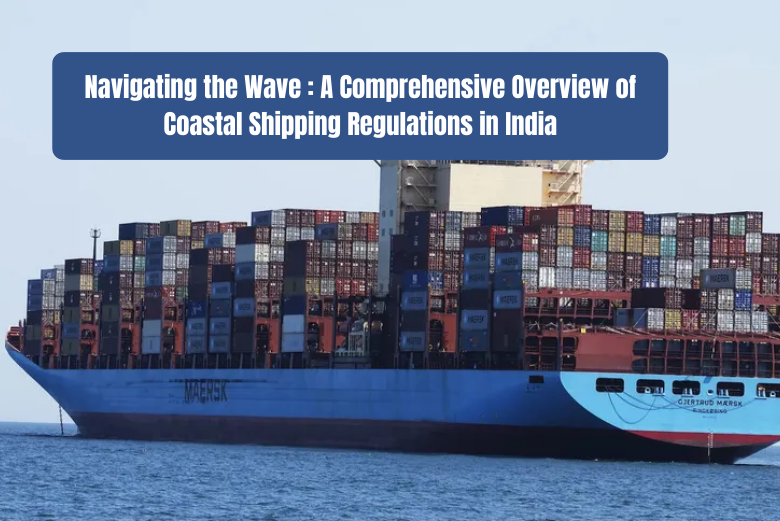Introduction:
Coastal shipping plays a pivotal role in India’s transportation network, connecting ports along the country’s extensive coastline. As a vital component of the maritime industry, coastal shipping is subject to a comprehensive set of regulations that govern various aspects of its operations. This blog provides an in-depth overview of coastal shipping regulations in India, highlighting key aspects that shape the industry.
1. Definition and Scope:
Coastal shipping in India is defined as the movement of goods and passengers between ports located along the Indian coastline. The scope includes transportation within the territorial waters, extending up to 12 nautical miles from the baseline. The Coastal Regulation Zone (CRZ) regulations further influence activities in these coastal areas, emphasizing environmental conservation and sustainable development.
2. Regulatory Authorities:
The Directorate General of Shipping (DGS), under the Ministry of Ports, Shipping, and Waterways, is the primary regulatory authority governing coastal shipping in India. The DGS formulates and enforces regulations to ensure the safety and security of coastal shipping operations. Additionally, individual coastal states may have their own maritime boards and authorities overseeing local aspects of coastal transportation.
3. Cabotage Policy:
India’s cabotage policy restricts the operation of foreign-flagged vessels for transporting goods within the country’s territorial waters. This policy aims to protect the domestic shipping industry by giving preference to Indian-flagged vessels, fostering growth and competitiveness. However, exemptions and relaxations may be granted based on specific criteria and national interests.
4. Customs and Clearance Procedures:
Customs procedures play a crucial role in coastal shipping operations. Goods transported through coastal shipping are subject to customs clearance processes, with documentation requirements similar to those for international shipments. The Customs Act and related regulations govern the clearance of goods, ensuring compliance with import/export norms and taxation.
5. Security Regulations:
Security is a paramount concern in coastal shipping, considering the potential vulnerabilities in maritime transportation. The International Ship and Port Facility Security (ISPS) Code, implemented by the DGS, mandates security measures for ships and port facilities. Coastal vessels must adhere to these regulations to ensure the safety of both goods and passengers.
6. Environmental Regulations:
Given the ecological significance of coastal areas, environmental regulations are crucial in coastal shipping. The Coastal Regulation Zone (CRZ) guidelines aim to balance developmental activities with environmental conservation. These regulations restrict certain activities within CRZ areas, emphasizing sustainable practices and minimizing the impact on coastal ecosystems.
7. Licensing and Registration:
To operate in coastal shipping, vessels must obtain relevant licenses and registrations. The DGS issues licenses to shipping companies and vessel operators, ensuring compliance with safety and operational standards. The registration process involves rigorous inspections and assessments to verify the seaworthiness of vessels and the competence of crew members.
8. Safety and Navigation Standards:
Safety standards in coastal shipping are aligned with international conventions and codes. Vessels must adhere to the International Maritime Organization’s (IMO) regulations, including the International Convention for the Safety of Life at Sea (SOLAS). Navigation standards, such as those outlined in the Indian Ports Act, govern the movement of vessels within port limits and coastal waters.
9. Crew Certification and Training:
The competence of the crew is a critical aspect of coastal shipping safety. The DGS mandates the certification of seafarers, ensuring that crew members possess the necessary qualifications and training to operate vessels safely. Regular training programs and assessments are conducted to maintain and upgrade the skills of maritime personnel.
10. Tariffs and Charges:
The Tariff Authority for Major Ports (TAMP) regulates tariffs and charges for services provided by major ports involved in coastal shipping. The guidelines issued by TAMP ensure transparency and fair practices in determining rates for various services, including vessel-related charges, cargo handling charges, and storage charges.
11. Incentives and Subsidies:
To promote and support coastal shipping, the Indian government offers incentives and subsidies to shipping companies. These may include subsidies on vessel construction, tax exemptions, and financial support for infrastructure development. These measures aim to enhance the competitiveness of coastal shipping as a cost-effective and environmentally friendly mode of transportation.
12. Future Prospects and Innovations:
As India looks towards the future, there is a growing emphasis on leveraging technology and innovation in coastal shipping. The adoption of digital platforms for cargo tracking, real-time communication, and data analytics is becoming more prevalent. Additionally, the integration of green technologies, such as eco-friendly vessels and alternative fuels, aligns with the global push for sustainable maritime practices.
Conclusion:
Navigating the regulatory framework of coastal shipping in India requires a comprehensive understanding of the diverse regulations governing the industry. From safety and security to environmental conservation and economic incentives, the regulatory landscape reflects the multifaceted nature of coastal transportation. As the industry continues to evolve, a harmonized approach between government authorities, shipping companies, and other stakeholders will be essential to ensure the seamless and sustainable growth of coastal shipping in India.



